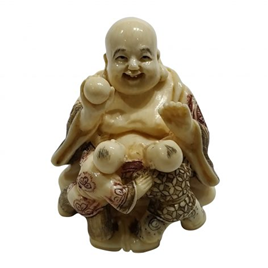Things You Didn't Know About Netsuke
During the 17th century, japan was a country without pockets. People had to hang items like tobacco, seals, medicine, and other personal effects from the sash or obi. This created a need for kits including the inro, tobacco pouches, and the yatate. An inro was a layered box with tiers ranging from two to seven containing various tiny items. Braided silk cords running vertically through the inro layers held it together. Keeping the cords together required the use of ojime that finally ended in a netsuke as a toggle piece.
Understanding Netsuke:
Suspending the inro below required tucking the netsuke under the obi. With human nature, these items began serving more than a utilitarian purpose. It was not long before artists began creating them in better versions. This gave customers to choose one to match their taste. The Japanese knew much about artistry, craftsmanship, adornment, and decoration. These little accessories were refined to reflect great sophistication. This was through various options including Inro made of wood coated with lacquer and decorated with silver inlays and gold. Netsuke was crafted in ivory, ceramic, and wood.
Netsuke significance in the modern world:
The true inro suite included ojime, netsuke, and inro with a unified theme. Inro suites portrayed great artistry and elegance just like women consider Prada bags today. Collectors of Japanese art are drawn by the exquisite beauty of the inros. These usually portray sophisticated lacquer work ever discovered. Tiny ojime beads marvel any beading enthusiast for their refinement and intricacy. Netsuke is collected for ingenious miniature designs and sculptural nature.
Types of Netsuke:
This comes in 3D with carving to detail every part of the subject. The best ivory netsuke is collected for sculptural quality and detail. Sashi netsuke was identified for its elongated form. This netsuke is curved like katabari netsuke on all sides differentiated by the thin body seemingly stretching out. Netsuke functioned like oversized buttons and was made with practical rules in mind. People used netsuke to attach a braided silk cord looking like two holes in the piece. Netsuke’s compact and unobtrusive body allowed easy wear without breakage.
Netsuke Design:
Artists created netsuke in various conceivable sculpture forms that could be confined in the tiny form. At first, it was possible to find netsuke that could speak to you for being initially simple bamboo pieces that evolved into great works of art. The Samurai would have netsuke made with iron by their favorite sword maker portraying legendary warriors
Identifying Quality Netsuke:
Netsuke comes in various forms and ages leading to differences in quality including crude shaped netsuke and subtler and ingenious netsuke. Older netsuke was characterized by style and patina. Netsuke made from ivory was prone to subtle wear on the surface to reveal use for hundreds of years. People attach this to particular energy the piece acquired throughout its life.
Older netsuke was fascinating for reflecting a particular era. Most netsuke alludes to famous legendary figures in old Japan. Netsuke also mirrors changing times in society. Early 19th and 20th-century netsuke portrayed flints, compasses, and model guns representing the war period. Contemporary netsuke combined traditions and artists’ inspirations.
Collecting Netsuke:
Just like collecting other pieces of art, you have to collect netsuke that you will enjoy. Perhaps you are delighted in netsuke portraying a special scene or animal. Many netsuke creators took natural color or shape variations in material to enhance the piece itself. The beauty of ivory or particular legends inspired other netsuke artists to make various products.
How to tell real Netsuke:
When it comes to authenticity, understand that pre-1920 netsuke was actually used and the most real. Pieces made after this period were for exporting to serve the huge demand. Some few grand artists carried on the netsuke tradition making netsuke with similar quality to antique netsuke. The 1980s saw a growth in netsuke reproduction from countries like the United States, Hong Kong, and Japan.
Identifying poor-quality netsuke is through inferior carving. This netsuke was made quickly with little finesse to capture the interest of eager novice collectors. When new to collecting netsuke, work with a professional with appropriate knowledge and experience. You can also tell fake netsuke for its practicality. Presence of encumbrances that might make the piece prone to wear is a red flag.
Contemporary Netsuke:
Netsuke created by contemporary artists is deeply rooted in the Japanese tradition and displays a high level of technical artisanship. Popular contemporary netsuke artists include Lynn Richardson and Gernot Schluifer for producing netsuke with sensitive and expressive rendering. Avid collectors of contemporary netsuke include Princess and late Prince Takamado.
Bottom Line:
Any art enthusiast or collector should include netsuke in their collection. Apart from being embodiments of Japanese tradition, netsuke makes wonderful décor and investment. Owning rare netsuke has the potential to increase your return on investment significantly. Netsuke is more likely to enhance value over time.


No comments